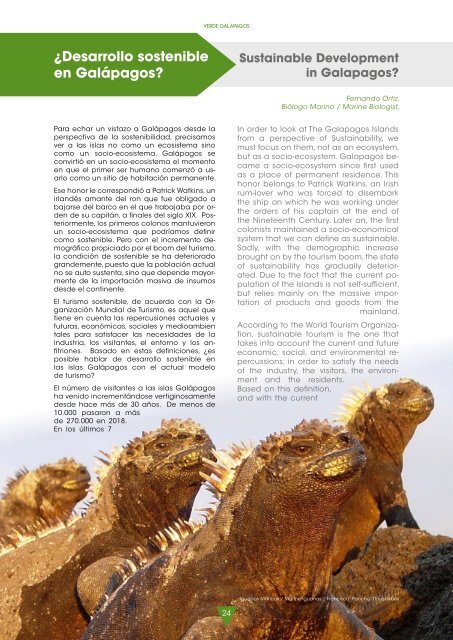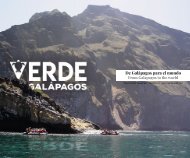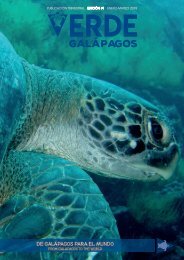Verde Galápagos #2
Te invitamos a leer nuestra segunda edición de la revista digital Verde Galápagos.
Te invitamos a leer nuestra segunda edición de la revista digital Verde Galápagos.
You also want an ePaper? Increase the reach of your titles
YUMPU automatically turns print PDFs into web optimized ePapers that Google loves.
verdE galápagos<br />
¿Desarrollo sostenible<br />
en <strong>Galápagos</strong>?<br />
Sustainable Development<br />
in Galapagos?<br />
Fernando Ortiz,<br />
Biólogo Marino / Marine Biologist,<br />
Para echar un vistazo a <strong>Galápagos</strong> desde la<br />
perspectiva de la sostenibilidad, precisamos<br />
ver a las islas no como un ecosistema sino<br />
como un socio-ecosistema. <strong>Galápagos</strong> se<br />
convirtió en un socio-ecosistema el momento<br />
en que el primer ser humano comenzó a usarlo<br />
como un sitio de habitación permanente.<br />
Ese honor le correspondió a Patrick Watkins, un<br />
irlandés amante del ron que fue obligado a<br />
bajarse del barco en el que trabajaba por orden<br />
de su capitán, a finales del siglo XIX. Posteriormente,<br />
los primeros colonos mantuvieron<br />
un socio-ecosistema que podríamos definir<br />
como sostenible. Pero con el incremento demográfico<br />
propiciado por el boom del turismo,<br />
la condición de sostenible se ha deteriorado<br />
grandemente, puesto que la población actual<br />
no se auto sustenta, sino que depende mayormente<br />
de la importación masiva de insumos<br />
desde el continente.<br />
El turismo sostenible, de acuerdo con la Organización<br />
Mundial de Turismo, es aquel que<br />
tiene en cuenta las repercusiones actuales y<br />
futuras, económicas, sociales y medioambien<br />
tales para satisfacer las necesidades de la<br />
industria, los visitantes, el entorno y los anfitriones.<br />
Basado en estas definiciones, ¿es<br />
posible hablar de desarrollo sostenible en<br />
las islas <strong>Galápagos</strong> con el actual modelo<br />
de turismo?<br />
El número de visitantes a las islas <strong>Galápagos</strong><br />
ha venido incrementándose vertiginosamente<br />
desde hace más de 30 años. De menos de<br />
10.000 pasaron a más<br />
de 270.000 en 2018.<br />
En los últimos 7<br />
In order to look at The Galapagos Islands<br />
from a perspective of Sustainability, we<br />
must focus on them, not as an ecosystem,<br />
but as a socio-ecosystem. Galapagos became<br />
a socio-ecosystem since first used<br />
as a place of permanent residence. This<br />
honor belongs to Patrick Watkins, an Irish<br />
rum-lover who was forced to disembark<br />
the ship on which he was working under<br />
the orders of his captain at the end of<br />
the Nineteenth Century. Later on, the first<br />
colonists maintained a socio-economical<br />
system that we can define as sustainable.<br />
Sadly, with the demographic increase<br />
brought on by the tourism boom, the state<br />
of sustainability has gradually deteriorated.<br />
Due to the fact that the current population<br />
of the Islands is not self-sufficient,<br />
but relies mainly on the massive importation<br />
of products and goods from the<br />
mainland.<br />
According to the World Tourism Organization,<br />
sustainable tourism is the one that<br />
takes into account the current and future<br />
economic, social, and environmental repercussions;<br />
in order to satisfy the needs<br />
of the industry, the visitors, the environment<br />
and the residents.<br />
Based on this definition,<br />
and with the current<br />
Iguanas Marinas / Marine Iguanas :: Francisco “Pancho” Dousdebés<br />
24





